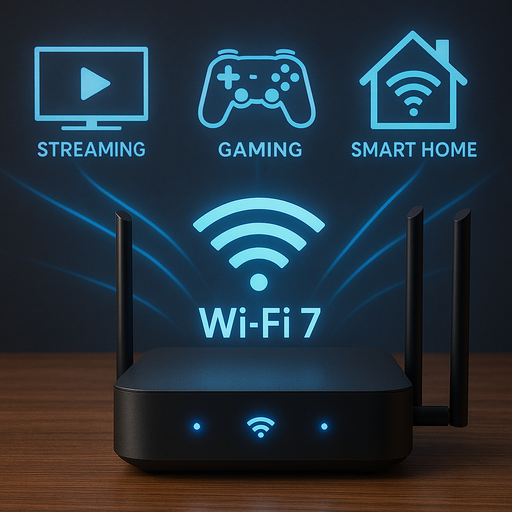Wi-Fi 7, also known as IEEE 802.11be, represents the latest generation of wireless network technology, bringing significant advances in speed, capacity, and efficiency. This article explores the characteristics, advantages, and applications of this new technology that is transforming our connectivity experience.

What is Wi-Fi 7?
WiFi 7 is the seventh generation of the IEEE 802.11 wireless network standard, officially designated IEEE 802.11be or Extremely High Throughput (EHT). It succeeds WiFi 6 (802.11ax) and WiFi 6E, representing a substantial technological leap in wireless network performance.
Main features and advancements of Wi-Fi 7.
Unprecedented Speeds
WiFi 7 can achieve theoretical speeds of up to 46 Gbps, more than three times the maximum speed of WiFi 6, which reaches approximately 9.6 Gbps. This extraordinary data transfer capacity enables almost instantaneous downloads of large files and streaming of ultra-high-definition content.
Increased Bandwidth
One of the most significant advances in WiFi 7 is the implementation of 320 MHz channels, double the width of WiFi 6’s 160 MHz channels. This expansion allows for greater data transfer capacity and support for more simultaneously connected devices.
4K-QAM Modulation
WiFi 7 adopts 4096-QAM (4K-QAM) modulation, a significant evolution from WiFi 6’s 1024-QAM modulation. This advanced technique allows for transmitting more bits per symbol, substantially increasing data transfer efficiency.
Multi-Link Operation (MLO)
A revolutionary innovation of WiFi 7 is its Multi-Link Operation capability, which allows devices to communicate simultaneously across multiple frequency bands (2.4 GHz, 5 GHz, and 6 GHz). This results in:
- Greater aggregate bandwidth
- Significant reduction in latency
- Better connection reliability
- More efficient use of available spectrum
Multi-Resource Unit (Multi-RU)
This technology allows for dynamic and flexible allocation of spectrum resources, optimizing the use of available bandwidth and significantly improving performance in environments with many connected devices.
Applications and Benefits
Virtual and Augmented Reality
With its low latency (less than 5 ms) and high transfer capacity, WiFi 7 is ideal for VR and AR applications that require real-time transmission of large volumes of data, enabling immersive experiences without interruptions.
Smart Homes and IoT
Enhanced support for multiple devices makes WiFi 7 perfect for smart homes, where dozens of IoT devices operate simultaneously, from security cameras to connected appliances.
8K and 16K Content Streaming
WiFi 7’s incredible bandwidth enables streaming video at extremely high resolutions without buffering, transforming the home entertainment experience.
Online Gaming
Gamers greatly benefit from the drastic reduction in latency and increased connection stability, providing more responsive and competitive gaming experiences.
Industrial and business applications of Wi-Fi 7.
In corporate environments, WiFi 7 supports critical real-time communications, facilitating industrial automation, high-quality video conferencing, and efficient sharing of voluminous data.

Challenges for Wi-Fi 7 adoption.
Despite its impressive benefits, WiFi 7 faces some challenges:
- Need for hardware upgrades in both routers and end devices
- Higher initial cost of compatible equipment
- Certification and standardization process still ongoing
- Regulatory limitations in some countries regarding the use of the 6 GHz band
Future perspectives for Wi-Fi 7.
WiFi 7 adoption is expected to accelerate significantly from 2025 onward, with the proliferation of compatible devices in the consumer market. Analysts predict that this technology will be crucial to sustaining the next generation of digital applications, including the metaverse, distributed cloud computing, and autonomous systems.
Conclusion
Wi-Fi 7 represents a monumental evolution in wireless network technology, establishing new benchmarks for performance, efficiency, and reliability. As compatible devices become more accessible, this technology promises to fundamentally transform our digital connectivity, enabling applications that were previously limited by network infrastructure and paving the way for future innovations in an increasingly connected world.
Discover more news and reviews by visiting our blog: https://emnews.online